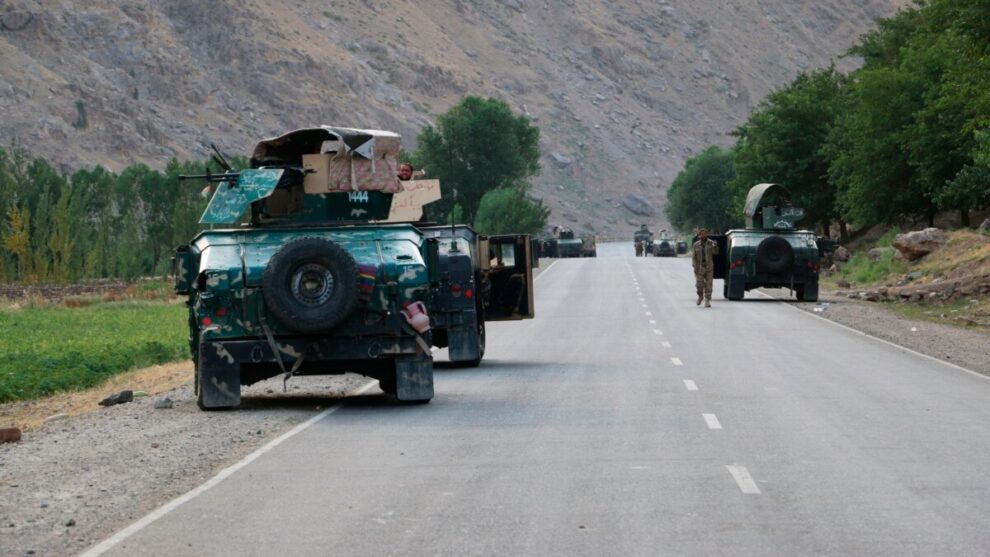In the first week of May 2024, spontaneous protests broke out over the Taliban’s killing of two civilians in the Darayim district of Afghanistan’s northeastern Badakhshan province before spreading to Argo district, with the protesters raising slogans such as “Death to the Taliban” and “Death to the Islamic Emirate.”[1] The protests are a nightmare for the Pashtun leadership, especially the powerful coterie under Taliban emir Mullah Hibbatullah Akhundzada.
The Islamic Emirate of Afghanistan (IEA, i.e., the Afghan Taliban) moved swiftly to paint the protests as resulting from the Taliban’s drive against poppy cultivation. In a statement dated May 4, the Taliban spokesman Zabihullah Mujahid stated: “Regrettably, there have been incidents where offenders attempted to attack the security forces involved in the fight against poppy cultivation, resulting in tragic events.”[2]

Spontaneous protests against the Taliban in Badakhshan province
However, ever since the IEA took power in Kabul in August 2021, the Pashtun Taliban officials have been mistreating non-Pashtun people in the northeastern regions, who are mostly Tajiks and Uzbeks. A journalist, commenting on the protests in Badakhshan, wrote: “In the northeast of Afghanistan, where the majority of inhabitants are Tajiks and Uzbeks, but the Taliban, who are Pashtun-dominated, rule oppressively over them, you can see the people’s anger and resentment everywhere.”[3]
In Darayim district, the residents shouted “death to the Taliban” and accused “the Pashtun Taliban” of having invaded “our homes and our dignity and raped our women.”[4] In Argo district, the protesters claimed that their wheat fields, gardens, and houses were destroyed by the Taliban security forces under the pretext of eradicating poppy fields and demanded that the Taliban government ensure justice and deploy other forces to destroy the poppy fields, according to a Tolo News report.[5]
Over the past two-plus years, the Pashtun Taliban have been disarming and removing the non-Pashtun Taliban, who are Tajik and Uzbek. In December 2021, Makhdoom Alam Rabbani, an Uzbek commander in the ranks of the Taliban, was arrested in Mazar-i-Sharif, Balkh province.[6] Another Uzbek commander, Salah ul-Din Ayubi, left the Taliban in Faryab province, accusing the Taliban leadership of having a “monopoly on power [to the] exclusion of other ethnic groups from within the system.”[7]
In recent months, long before the current protests, the Pashtun leadership removed Mullah Amanuddin Mansoor as the governor of Badakhshan when he was on a pilgrimage and Mullah Hafiz from the security command of 219th Omar Al-Third, replacing them respectively with Mohammad Ayoub Khalid and Mullah Azizullah Haqyar, both of whom are Pashtun.[8] In April and May 2022, more than 300 Kandahari Taliban, i.e., the Pashtuns loyal to the Taliban emir, were deployed in Badakhshan, replacing the Uzbek and Tajik commanders.[9] A number of senior officials in Badakhshan and other northern provinces are now Pashtuns.
In mid-April 2024, the Pashtun Taliban disarmed Mawlawi Qadir, an Uzbek commander in the Taliban ranks of Takhar province, according to a report published by Khorasan Times.[10] Mawlawi Qadri was the Taliban governor for Khwajah Ghar district. “It is worth noting that with the Taliban’s rule, clashes between Taliban factions and the purge of Tajiks and Uzbeks from the group’s ranks in the north are not new and occur from time to time,” a media report noted.[11] As the protests continued in Badakhshan, the Taliban officials raided the homes of 15 members of the Ismaili sect of Shi’ism in Nasi district and imprisoned them on charges of joining the anti-Taliban resistance.[12]
On May 10, Aamaj News shared a video and a tweet, saying that several non-Pashtun Taliban members from Balkh, Panjshir, Kapisa, and Parwan provinces sent videos expressing support for the Taliban commander Abdul Hamid Khorasani, who is from Panjshir province and has expressed concern over the incidents in Badakhshan, questioning the Taliban leadership for ethnic bias in this matter.[13] Aamaj News noted that this is the first time during three years of the Taliban rule over Afghanistan that non-Pashtun Taliban have publicly spoken against ethnic bias toward non-Pashtun members in the Taliban ranks.[14]
Challenging The Pashtun Taliban
Clearly, the Taliban leader Mullah Hibbatullah Akhundzada is fearful of the non-Pashtuns in the Taliban ranks. The Taliban emir has been implementing a considered policy of removing the non-Pashtuns. And the man who executes this policy in northern provinces is Mullah Muhammad Yusuf aka Haji Wafa, the governor of Balkh. In February 2024, Etilaat Roz published a Dari-language article, noting how Haji Wafa has emerged as the “new emperor of Balkh” and the Taliban emir’s “shadow” in northern Afghanistan, especially targeting and disarming the Tajik and Uzbek commanders in the Taliban ranks.[15]
“Efforts have been made by the Taliban leadership to completely exclude the Badakhshani Taliban from power in this province,” journalist Mohammad Ali Nazari noted, adding: “The Taliban leadership worries that a shift in circumstances could spark internal disputes within their group. They fear that if the Tajik-origin Badakhshani Taliban, particularly those based in resource-rich areas of the same province, unite, they might present a significant challenge.”[16]
“Recognizing the situation, the Taliban leadership is worried about possible resistance from the Badakhshani Taliban to their decisions, especially if these factions are armed. To address this, they have removed military leaders from Badakhshan and taken away their official positions. Additionally, steps are being taken to disarm these fighters,” Mohammad Ali Nazari added.[17]

Spontaneous protests against the Taliban in Badakhshan province
The National Resistance Front (NRF) of Afghanistan is the main anti-Taliban resistance led by Ahmad Massoud whose members are frequently targeted, arrested, and killed by the Taliban security forces. In a May 5 statement, the NRF announced special operations in Kabul in support of the protesters in Badakhshan, noting that NRF fighters carried out two operations in Kabul: one at the entrance the Taliban’s Ministry of Interior, killing two Taliban members, and the other in the ninth security district of Kabul, killing two more.[18]
The NRF said that its special operations are planned for another month and “will continue in support of the freedom and justice-seeking people of Badakhshan” while aiming “to destroy the enemies of the people and free the country from the illegitimate rule of the terrorist and occupying Taliban group.”[19]
The National Resistance Council (NRC) for the Salvation of Afghanistan – another key resistance group led by Ata Mohammad Noor, Abdul Rab Rasul Sayyaf, Abdul Rashid Dostum, Haji Mohammad Mohaqiq and others – said: “The uprising of the people of Badakhshan against the despotism and violence of the Taliban, a spontaneous popular movement, will undoubtedly not be limited to one province and will soon evolve into widespread rebellions across the country as the public conscience is further aggrieved.”[20]
“The Taliban forces took advantage of the Friday prayer gathering, where men were present in the mosque, to enter the homes in the Darayim district of Badakhshan province under the pretext of destroying poppy fields, causing harassment and distress to the people. This aggressive action by the Taliban sparked public outrage, leading to protests in defense of their rights. The Taliban responded to this public outcry and protest by opening fire, resulting in the martyrdom and injury of several protestors,” it said.[21]
The NRC further said: “The behavior of the Taliban, especially in the recent incident in Badakhshan, demonstrates that this ruthless suppression is not due to poppy cultivation but is politically motivated, as the Taliban themselves promote poppy cultivation in many parts of the country and their economy has historically been based on it. This duplicitous policy is politically motivated.”[22]
The Taliban’s Fear Of A Major Uprising
Barring Abdul Hamid Khorasani and some Taliban commanders loyal to him who reportedly quit in protest against ethnic bias against Tajiks and Uzbeks, most non-Pashtun commanders the Taliban ranks are silent. A question arises as to why they have not yet raised their voice. This is perhaps because, as some journalists in Kabul suggest in private conversations, the non-Pashtun Taliban commanders are still weak and are afraid that if they protest, they will suffer like the Shi’ite Hazara Taliban commander Mehdi Mujahid. A resident of Sar-i-Pul province, Mehdi Mujahid, perhaps the only Shi’ite Hazara to have worked with the Taliban for years, was killed by the Taliban forces in Herat for protesting the Taliban policies on August 17, 2022.[23]
However, it is not just the Pashtun hegemony – cautioned journalist Aamoonpur – at the root of the problem in Badakhshan and its surrounding region: “The inhabitants of the northeastern provinces are forcibly ruled by a small ethnic minority that has only been able to govern the people through the force of guns and threats. The protesters in Badakhshan clearly state in their speeches that they are tired of the rule of ‘Kandaharis and Helmandis’ and that they must return to their regions. It is not just Pashtun hegemony over the northeast that has caused tension. Poverty, unemployment, rampant corruption, and maximum suppression of citizens through various means of insult, humiliation, and coercion are other factors that have led people to protest against the Taliban to vent their anger.”[24]

The Taliban killed Shi’ite Hazara Taliban commander Mehdi Mujahid for speaking out.
As the third anniversary of the Taliban’s capture of Afghanistan approaches on August 15, 2024, the Islamic Emirate faces three resistance fronts. One, the international community has so far refused to recognize its government and the Taliban have not been able to take Afghanistan’s seat at the United Nations. Two, during two decades of the Republican governments, Afghanistan witnessed vibrant journalistic and political freedoms, engendering awareness about women’s rights and individual liberties. The women, forced behind veils and speaking on the web from inside closed rooms, continue to speak against the Taliban’s theocratic rule. And now, a third anti-Taliban resistance front is emerging. People’s protests against the Taliban in Badakhshan, Maidan Wardak, Baghlan, and Herat, could spawn into a major uprising.
Hasht-e-Subh, an independent newspaper of Afghanistan, observed in an editorial: “Recent events in Badakhshan, Nangarhar, and several other parts of the country, marked by clashes between the people and Taliban forces, are clear indicators of shifting dynamics. Audio clips of Taliban commanders, disseminated to the public, revealed their profound apprehension towards widespread public reactions. Their emphatic warnings and menacing threats to quell dissent and silence opposition to the Emirate’s decisions signify a reversed situation, where now it is the people taking action and the Taliban feeling intimidated.”[25]
The editorial concluded: “Recent events in eastern and northeastern Afghanistan have shown that Taliban rule is highly fragile, and even the slightest public reaction can pose a significant challenge and instil fear and terror within the Taliban regime. If anti-Taliban groups could overcome their internal differences and consolidate their scattered efforts in the future, the readiness of the people to confront the Taliban is such that it could soon undermine the foundations of their rule. Any system not based on the will and consent of the people and enforced upon them by force has no fate other than collapse…”[26]
[1] 8am.media (Afghanistan), May 6, 2024.
[2] AlemarahEnglish.af (Afghanistan), May 4, 2024.
[3] 8am.media (Afghanistan), May 6, 2024.
[4] Twitter.com/womenaidafghan1, May 3, 2024.
[5] ToloNews.com (Afghanistan), May 6, 2024.
[6] 8am.media (Afghanistan), October 18, 2022.
[7] 8am.media (Afghanistan), October 18, 2022.
[8] 8am.media (Afghanistan), January 9, 2024.
[9] 8am.media (Afghanistan), May 7, 2022.
[10] Twitter.com/Khorasan_Times, April 12, 2024.
[11] AamajNews24.com (Afghanistan), April 12, 2024.
[12] Etilaatroz.com (Afghanistan), May 7, 2024.
[13] Twitter.com/aamajnews_24, May 10, 2024.
[14] Twitter.com/aamajnews_24, May 10, 2024.
[15] Etilaatroz.com (Afghanistan), February 23, 2024.
[16] 8am.media (Afghanistan), January 9, 2024.
[17] 8am.media (Afghanistan), January 9, 2024.
[18] Twitter.com/NRFafg, May 5, 2024.
[19] Twitter.com/NRFafg, May 5, 2024.
[20] NRCafghanistan.com (Afghanistan), May 6, 2024.
[21] NRCafghanistan.com (Afghanistan), May 6, 2024.
[22] NRCafghanistan.com (Afghanistan), May 6, 2024.
[23] 8am.media (Afghanistan), May 17, 2022.
[24] 8am.media (Afghanistan), May 6, 2024.
[25] 8am.media (Afghanistan), May 11, 2024.
[26] 8am.media (Afghanistan), May 11, 2024.
Source: MEMRI









